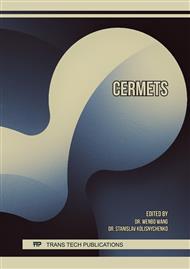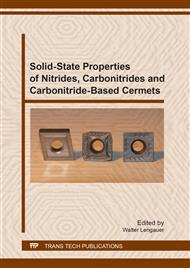[1]
Critical raw materials for the EU", Raw Material Supply Group, European Commission, Entreprise and Industry, July (2010).https://ec.europa.eu/growth/sectors/raw-materials/specific-interest/critical_en.
Google Scholar
[2]
Report on Critical Raw Materials for the EU, May 2014, Report of the Ad hoc Working Group on defining critical raw materials. http://www.catalysiscluster.eu.
Google Scholar
[3]
M. Seo, J. Kim, S. Kang, Int. Journal of Refractory Metals and Hard Materials 29 (2011) 424–428.
Google Scholar
[4]
V.T. Golovchan, Int. Journal of Refractory Metals and Hard Materials 26 (2008) 301–305.
Google Scholar
[5]
H. Doi Advanced TiC and TiC-TiN based cermets,, Inst. Phys. Conf. Ser. No. 75, Chapter 6, Bristol and Boston: Adam Hilger Ltd.; Almond E A, Brookes C A, Warren R, Eds., (1986), 489-523.
Google Scholar
[6]
H. Suzuki, H. Matsubara, J. Japan Soc. Powder Powder Metall., (1983), 30, 257-262.
Google Scholar
[7]
Pastor H., Mater. Sci. Eng., (1988), A105/106, 401-409.
Google Scholar
[8]
Ettmayer P., Kolaska H., Lengauer W, Dreyer K, Int. J. Refract. Met. H., (1995), 13, 343-351.
Google Scholar
[9]
I. Iparraguirre, N. Rodriguez, F. Ibarreta, R. Martinez and J.M. Sanchez, Int. Journal of Refractory Metals and Hard Materials 43 (2014), 125–131.
DOI: 10.1016/j.ijrmhm.2013.11.012
Google Scholar
[10]
L. Chen, W. Lengauer, P. Ettmayer, K. Dreyer, H.W. Daub, D. Kassel, Int. J. Refract. Met. H., (2000), 18, 307-322.
Google Scholar
[11]
Jung J., Kang S., Acta Mat., (2004), 52, 1379-1386.
Google Scholar
[12]
Ahn S.Y., Kang S., J. Am. Ceram. Soc., (2000), 83, 6, 1489-1494.
Google Scholar
[13]
Park S., Kang S., Scripta Mat., (2005), 52, 129-133.
Google Scholar
[14]
Demoly A., Lengauer W., Veitsch C., Rabitsch K., Int. J. Refract. Met. H., (2011), 29, 6, 716–723.
Google Scholar
[15]
D.K. Chaudhuri, D. Xie, A.L. Lakshmanan, Wear 209 140-152, (1997).
Google Scholar



